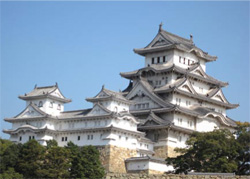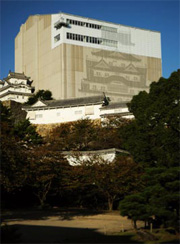Home > Highlighting JAPAN > Highlighting Japan DECEMBER 2011 > Conserving the "White Heron"
Highlighting JAPAN
COVER STORY: Pillars of Strength
Conserving the "White Heron"
In 2009, a five-year project was launched to carry out repairs to the main keep of Himeji Castle in Himeji, Hyogo Prefecture. Toshio Matsubara went to see the castle in its full glory, now more visible than ever while repairs are ongoing.

Himeji Castle prior to the start of restoration work, April 2010. The main keep of the castle has five levels with white plaster walls. The castle was listed as a World Heritage Site in 1993.
With five levels standing approximately 31 meters off the ground, the main keep which is now undergoing reconstruction was built by the owner of the castle, then the ruler of the local area, at the start of the seventeenth century, as part of a castle expansion project. The keep was the largest structure on the castle's site and served as Himeji's last defensive stronghold.
With a history dating back over 400 years, the main keep actually underwent major repair work during the eight-year period from 1956 to 1964, when it was dismantled and fully restored. As the main keep's roof and walls had fallen into disrepair during the intervening half-century however, a new five-year preservation and repair project has been underway since 2009.

Himeji Castle covered by roofed scaffolding. The visitor facilities in the scaffolding are open from 9:15 to 16:30 (Sept. 1–Apr. 26) and from 9:15 to 17:30 (Apr. 27–Sept.1).
While work is ongoing, roofed scaffolding has been erected over the entire main keep, to protect it from the elements and ensure that repairs are able to progress smoothly and safely throughout. As World Heritage status extends to the grounds surrounding the castle as well as the buildings themselves, the scaffolding could not be attached directly to the roof or walls, and the builders were not permitted to drive stakes into the ground. Steps also had to be taken to prevent the weight of the roofed scaffolding from distorting the ground in any way. The solution came in the form of a steel frame truss structure designed to be as lightweight as possible.
The processes of replastering the walls of Himeji Castle and replacing its roof tiles involve techniques that have been passed down unchanged for around 400 years, since the castle was first completed.
The walls on the upper fourth and fifth levels have been completely stripped back and refinished from the clay outwards, while the walls on the lower three floors are being replastered on the surface but left the same underneath. The type and thickness of plaster varies depending on its location within the tower. It is a technique that requires great skill, taking into consideration seasonal fluctuations in temperature and humidity to determine whether to apply the next layer when the plaster has fully dried or while there is still some moisture in the previous layer.
All of the roof tiles, which number approximately 80,000, are being removed so that they can be individually scrutinized and cleaned. Any damaged or worn tiles are replaced with new ones.
Carrying out repairs with such a commitment to traditional techniques also helps to preserve these invaluable skills for future generations.
Visiting Himeji Today
While it may not be possible to see the main keep from the outside at the moment, there are nonetheless facilities for visitors inside the roofed scaffolding so that they can see the repair work in progress. Visitors can take the elevator to the uppermost eighth floor and take a look at ongoing repairs to the roof of the top floor of the tower for themselves, or go down to the seventh floor to see repairs to the walls through viewing windows. With such unique views on offer exclusively while repairs are ongoing, the castle is still attracting crowds of visitors every day.
A woman in her twenties from Australia commented, "I am so happy I came while all this is going on. Usually, you only get to see the castle from a distance, but now you can see each individual curve in the roof and the stripped clay walls up close. I've been to see other Japanese castles, but Himeji is definitely the best. This experience has been a real privilege."
© 2009 Cabinet Office, Government of Japan






